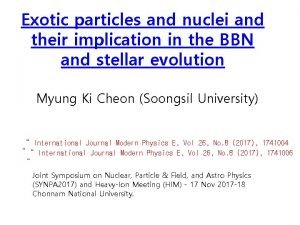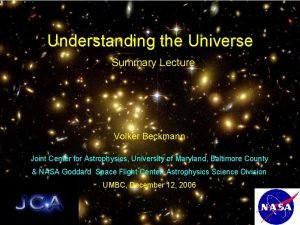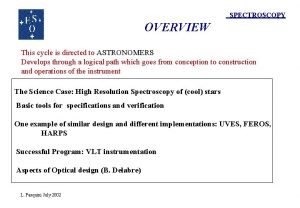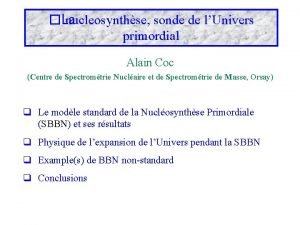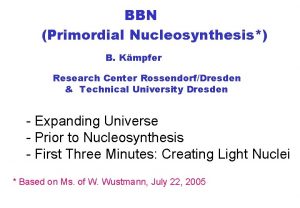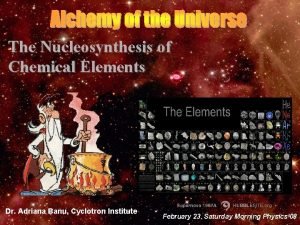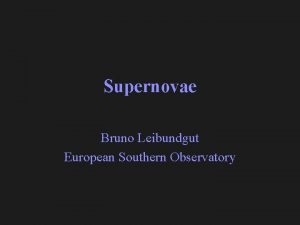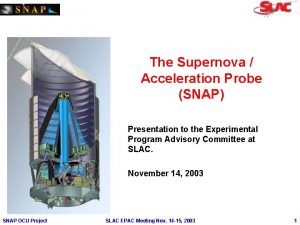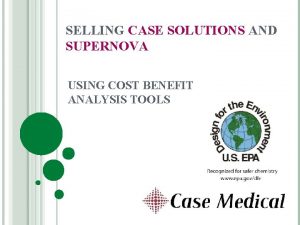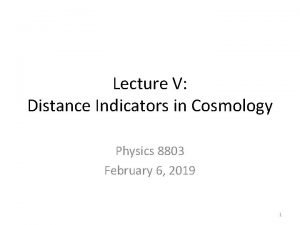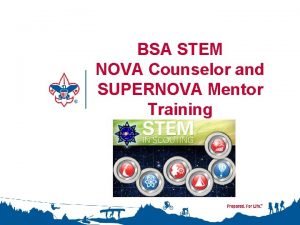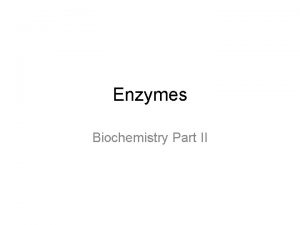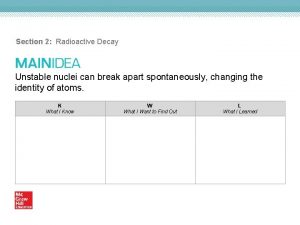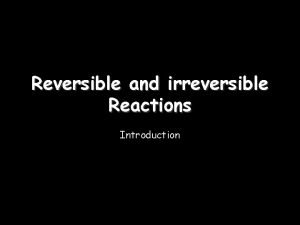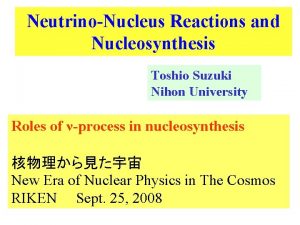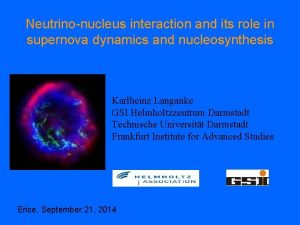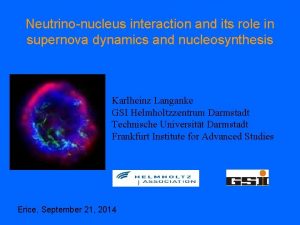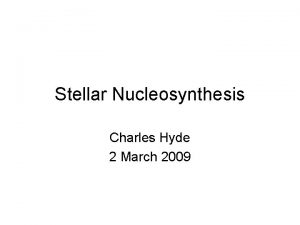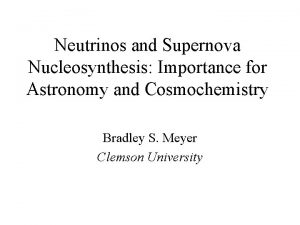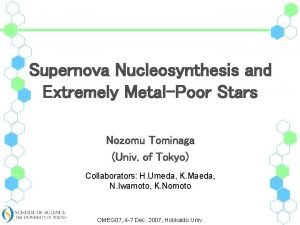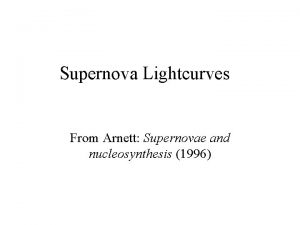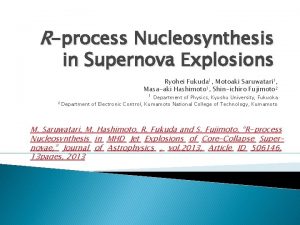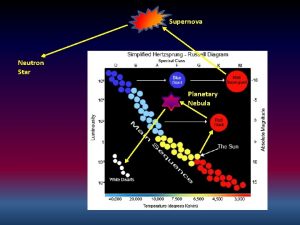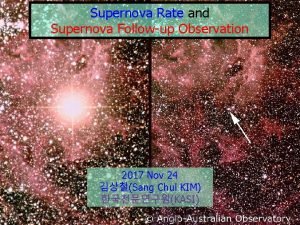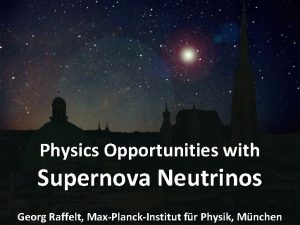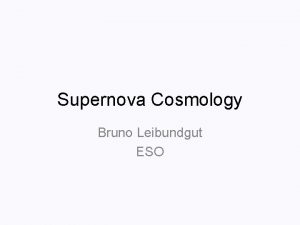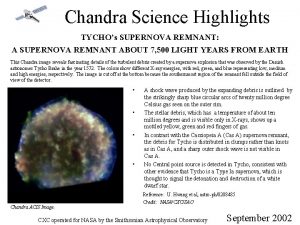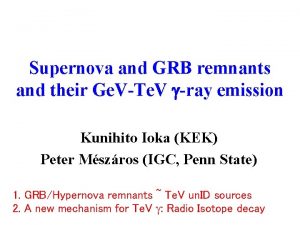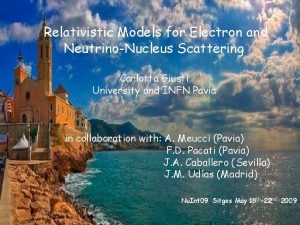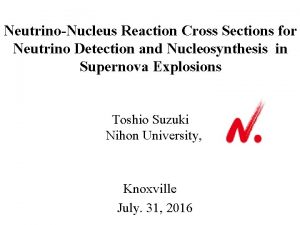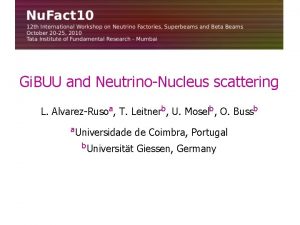Neutrinonucleus reactions and their role in supernova nucleosynthesis




























- Slides: 28

Neutrino-nucleus reactions and their role in supernova nucleosynthesis Karlheinz Langanke GSI Helmholtzzentrum Darmstadt Technische Universität Darmstadt Facility for Antiproton and Ion Research CNNP Hermanus, February 24, 202ß

Contents 1) origin of supernova neutrinos 2) description of neutrino-nucleus reactions; validation 3) neutrino nucleosynthesis

Core-collapse supernovae Roland Diehl

Neutrino spectra and luminosity production mechanism: electron capture (collapse, burst, only v_e) pair production (cooling, all v‘s) ‚low‘ energies response: Gamow-Teller transitions forbidden transitions at higher E spectra slightly distorted towards lower energies comared to Fermi-Dirac Mirizzi et al. , NCim. R 39 (2016) 1

Describing neutrino-nucleus reactions Neutrino energies (and momentum transfer) are low enough that allowed transitions dominate. However, forbidden contributions become important at higher neutrino energies. Hybrid model (Martinez-Pinedo, Kolbe; Suzuki et al. ): allowed transitions: shell model forbidden transitions: RPA

Validation: charged-current reactions anti-electron neutrino cross sections more sensitive to nuclear structure effects (like in electron capture) Zegers, Brown et al.

Experiment vs shell model Cole, Zegers et al. , PRC 86 (2012) 015809 Iron-nickel mass range under control With increasing density, less sensitivity to details of GT distribution -> models less sophisticated than shell model suffice, e. g. QRPA

Validation: charged-current reaction electron neutrinos shell model vs (p, n) data Martinez-Pinedo Rapaport et al. hybrid model vs QRPA differences at small neutrino energies (sensitivity to GT details) Paar, Marketin, Vretenar

Neutrino-nucleus reactions in supernova simulations charged-current reactions (nu+A, nubar+A) are inverse of electron and positron captures and are considered via detailed balance neutral-current reactions (inelastic scattering): not considered until recently Note: Nuclear pair-deexcitation considered for the first time. Unimportant for dynamics. However, source of mu, tau and anti-nu_e during collapse phase. (Fischer et al. )

Inelastic neutrino-nucleus scattering at finite temperature • Approach 1 (based on hybrid model): T=0 cross section + Gamow-Teller from (a few) excited states + contributions from inverted GT transitions (Juodagalvis, Martinez-Pinedo, Sampaio, . . . ) * Approach 2: Thermal Quasiparticle RPA consistent QRPA at finite temperature (Dzhioev, Wambach, Ponomarev)

Approach 1: Hybrid model validation from high-precision electron scattering data scattering on excited states dominates at low energies (Martinez-Pinedo, Richter, von Neumann-Cosel)

Approach 2: Thermal QRPA GT dominates, finite T effects only important at low neutrino energies Dzhioev, Wambach, Ponomarev

Neutrino-nucleus reactions and its role in nucleosynthesis neutrino-driven wind on top of proto-neutron star: neutrino absorption on nucleons sets proton/neutron ratio Ye if Ye > 0. 5: vp process if Ye < 0. 5: r-process modern simulations predict only conditions for weak r-process (up to A~130) neutrino process in outer burning shells

Neutrino nucleosynthesis

Neutrino-induced knock-out reactions Two-step procedure: 1) neutrino-induced excitation (charged or neutral) calculated via shell model or RPA 2) decay described by statistical model (Non-smoker (T. Rauscher))

Stellar yields

Neutrino nucleosynthesis

Why are we interested in neutrino nucleosynthesis? a) element synthesis (Li, B, F, La, Ta) b) constraint on those neutrino types not observed in 1987 a (electron neutrinos, mu and tau neutrinos and antineutrinos) c) neutrino thermometer (Haxton) 14 Me. V < <E_nu> < 20 Me. V for mu, tau neutrinos from 7 Li and 11 B production (Yoshida, Kajino et al, PRL 96 (2006)) d) hierarchy of average neutrino energies (Woosley et al) electron nu < electron anti-nu < mu, tau nu, anti-nu -> constraints on neutrino properties via neutrino oscillations?

Effect of neutrino oscillations basic idea: flip spectra by oscillations a) „large“ effect for neutrinos b) „small“ effect for anti-nu c) unimportant for neutral current reactions d) relevant for chargedcurrent reactions Yoshida et al. , PRL 96 (2006) 091101

7 Li/11 B ratio: a testcase + alpha n C 7 Li production dominated by charged-current 11 B production dominated by neutral-current increased by oscillations: negligible effect due to oscillations strong by nu_e: normal hierarchy weak by anti nu_e: inverted hierarchy Yoshida, Kajino, Yokomakura, Kimura, Takamura, Hartmann, PRL 96 (2006) 091101

Impact on neutrino spectra production yields averaged over stellar Salpeter mass function in modern supernova simulations neutrino spectra are shifted to lower energies and become more similar for different neutrino types (Sieverding et al. , Astr. J. 865 (2018) 143)

Sieverding et al. , Astr. Journ. 876 (2019) 151

Production factors

Stellar simulation approach 1 a: full t-dependent pinched spectra approach 1 b: full t-dependent, Fermi-Dirac spectra approach 2: averaged neutrino energies for full after-bounce phase approach 3: averaged neutrino energies, only cooling phase shock wave destroys early high-energy v-process yields survive shock wave

Thanks to: Andre Sieverding Hans-Thomas Janka Robert Bollig Andrius Juodagalvis Ralph Hix Alexander Heger Jorge Sampaio Gabriel Martinez-Pinedo

Thanks to: Andre Sieverding Hans-Thomas Janka Robert Bollig Andrius Juodagalvis Ralph Hix Alexander Heger Jorge Sampaio Gabriel Martinez-Pinedo

p-process in hydrogen rich, high neutron flux environments On-site neutron production through neutrino induced interaction: 1 H( +, e+)n! By-passing waiting point nuclei 64 Ge, 68 Se by ncapture reactions.

Producing 138 La Heger Woosley Kolbe Martinez-Pinedo Haxton 138 La is being produced by (v, e) reaction on 138 Ba, which has been previously produced by s-process. The respective GT cross sections have been measured at RCNP in Osaka.
 Exotic nucleosynthesis
Exotic nucleosynthesis Primordial nucleosynthesis
Primordial nucleosynthesis Hyades
Hyades Primordial nucleosynthesis
Primordial nucleosynthesis Primordial nucleosynthesis
Primordial nucleosynthesis Stellar nucleosynthesis
Stellar nucleosynthesis Eso supernova programm
Eso supernova programm Supernova acceleration probe
Supernova acceleration probe Steris decontamination sinks
Steris decontamination sinks Supernova spectra
Supernova spectra Supernova
Supernova Supernova mentor
Supernova mentor Section 2 classifying chemical reactions worksheet answers
Section 2 classifying chemical reactions worksheet answers What are redox reactions examples
What are redox reactions examples Section 2 classifying chemical reactions worksheet answers
Section 2 classifying chemical reactions worksheet answers Chemical reactions section 3 reactions in aqueous solutions
Chemical reactions section 3 reactions in aqueous solutions Chemistry unit 5 reactions balancing reactions worksheet
Chemistry unit 5 reactions balancing reactions worksheet Biology-roots.com
Biology-roots.com C# azure worker role example
C# azure worker role example Krappmann role taking
Krappmann role taking Statuses and their related roles determine
Statuses and their related roles determine From ancient grudge break to new mutiny modern english
From ancient grudge break to new mutiny modern english Nuclear decays and reactions section 2
Nuclear decays and reactions section 2 Reversible and irreversible reactions
Reversible and irreversible reactions Reduction reaction
Reduction reaction Electrochemical cell vs galvanic cell
Electrochemical cell vs galvanic cell Reactants and products
Reactants and products Chapter 8 review chemical equations and reactions section 2
Chapter 8 review chemical equations and reactions section 2 Chapter 8 section 1 chemical equations and reactions
Chapter 8 section 1 chemical equations and reactions
